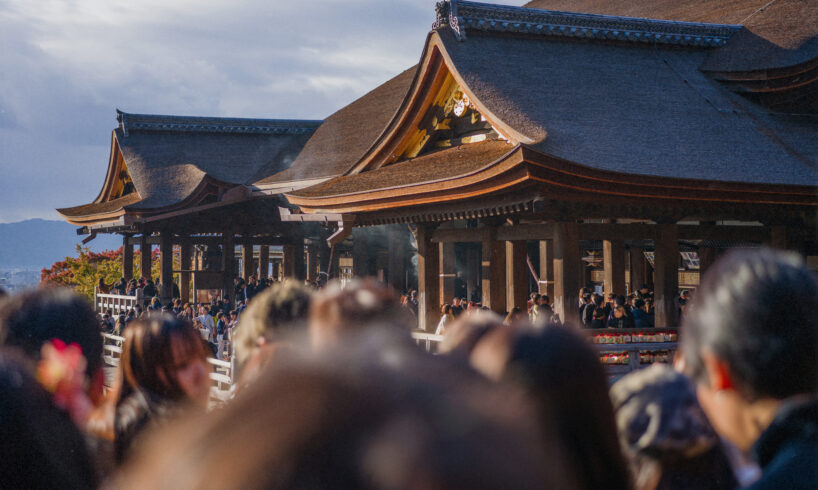
In recent years, as Japan has seen a steady surge in overseas visitors, the issue of overtourism has come to the fore. Kyoto, in particular, is bearing the brunt of it: reports tell of disrespectful tourists crowding streets, hounding apprentice geisha, defiling legendary temples and generally treating the ancient capital like a theme park or a mere backdrop for Instagram photos.
By now, the phenomenon is known throughout the world, having been documented in nearly every major media outlet. Kyoto and Tokyo both made Fodor’s “No List” this year, and a recent New York magazine article detailed at length the current state of affairs: swarms of disrespectful tourists treating the historic city like “an amusement park” or “a safari.”
As a traveler with good intentions and a sense of respect, overtourism creates a difficult conundrum. After all, overtouristed places are heavily visited for a reason — they’re beautiful, unique and rich in history. It’s hard to fault visitors for wanting to experience the ancient capital’s magic; truthfully, when my friends visit Japan, I still highly recommend Kyoto to them.
So what’s the best way to address this problem? According to locals and insiders, it’s still quite possible to plan a trip to Kyoto in a way that honors local culture and doesn’t cause a disturbance. You just have to be mindful, conscientious and prepared to forgo some of the most raved-about sites.
The Area Surrounding Kiyomizu-dera
The Overtourism Problem in Kyoto
I’ve lived a large chunk of my life in Japan, but I’ve only gone to Kyoto a handful of times. Admittedly, I find that the packed crowds — particularly in the areas surrounding Kiyomizu-dera, Fushimi Inari Taisha and Arashiyama Bamboo Forest — detract from the serene energy these sites are known for. Ironically, though, when I went on a trip to Kyoto with my college friends who were visiting from the States, these were the very spots I took them to — because, well, “you just have to.”
The city of Kyoto has a population of about 1.4 million, and in 2024, Kyoto drew 10.88 million foreign visitors. According to New York, roughly 150,000 people visit the city every day. Most of these visitors crowd the same few places — the ones I mentioned above, plus a few others (Kinkaku-ji, Nijo Castle, etc.).
For Kyoto residents, the constant influx of tourists can be incredibly disruptive. Daily life is often affected by overcrowded public transport and large groups of inconsiderate visitors, particularly in popular districts like Higashiyama and Arashiyama, which can feel nearly impassable at peak times. In a survey conducted by Yomiuri Shimbun in fall 2023, around 90% of 5,500 local respondents expressed frustration with the congestion on buses and trains caused by tourism.
And it’s not just in public places that the disruptions occur. New York describes a phenomenon of clueless tourists “opening the sliding doors into unmarked machiya on the presumption that anything inside was meant for their entertainment, only to end up walking into someone’s living room.”
Fushimi Inari Taisha Torii
The Tourist Dilemma
On a rainy June day, I was visiting the Tokyo National Museum with a friend from the US, catching the temporary special exhibition of modern-day ukiyo-e paintings. As I was struggling to get my umbrella out of its locked holder, my friend offhandedly mentioned that seeing other, conspicuously American tourists — inappropriately dressed, loud and pushy, acting with little regard for Japanese cultural norms — makes him feel embarrassed about his country. “Tourism inevitably dilutes a place, especially somewhere like Japan,” he said.
I hadn’t really thought much about tourists in that way. I didn’t think much about them at all, beyond being mildly annoyed by the masses filming videos at Shibuya Crossing when I have places to be, dammit. Like a true Tokyoite, I generally have tunnel vision as I walk and think of the people in my path not by country of origin but obstacles I must avoid.
I didn’t really understand what my friend was trying to say until I went to Milan for vacation the following week. Suddenly, my role was reversed. The ongoing joke is that everyone and their mothers are either going to Japan or Italy right now, but there’s some truth to it. I heard more English than Italian on the streets. When I visited Lake Como, I was stunned by its beauty — but also heartbroken by how gentrified it felt. Many longtime residents have been pushed out by soaring prices, their homes replaced by tourists and millionaires.
My Japanese instinct for kizukai (consideration for others) kicked in as a tourist in Italy. I was extremely aware of the fact that I was a visitor, taking up space in a city that wasn’t mine. I felt bad about my limited Italian vocabulary, stammering my lunch order to a waiter who smiled generously and responded in fluent English. I instantly felt more sympathetic towards foreigners in Japan, where it’s much harder to get by with just English.
I couldn’t help but feel strong parallels between Milan and Kyoto. Both cities draw massive crowds largely because of their deep, tangible histories — steeped into the architecture and embedded in the land itself. The shrines and temples of Kyoto evoke a similar awe to Italy’s grand cathedrals. In my mind, the Duomo di Milano and Kiyomizu-dera feel like two sides of the same coin.
As a tourist, I felt surprisingly guilty. Guilty for potentially, in a however minute way, changing the landscape of a country with so much history. For being one of the thousands of people visiting the Duomo, contributing to an already packed place that’s supposed to be a spiritual refuge.
Kinkaku-ji Temple
The Problem of “Must-See” Places
Overtourism is, in many ways, fueled by the collective desire to check out a select few “must-see” spots. It doesn’t help that so much of travel has become performative nowadays, fueled by a desire for bragging rights and perfectly posed and filtered Instagram posts. On TikTok, influencers tout “must-eat” and “must-visit” items, which their followers bookmark in order to create content of their own. I’m not criticizing this phenomenon — I understand that this is what it is to travel in the modern world. I do the same things myself: When I’m getting ready for a trip, I bookmark travel TikToks and reels, and I commemorate my international adventures with curated photo dumps.
But it’s important to remember there’s much more of a city than what one sees on the Explore Page, and that travel isn’t meant to be effortless. It requires thought and planning. “The thing that gets me is that Kyoto is huge, and there are so many places that are still almost empty,” Joshua Lassman-Watts, CEO of luxury travel company Untold Japan, says. “The problem seems to be that tourists only want to go to the same spots. What happened to curiosity and adventure?”
As we’ve written before, it’s an oversimplification to say that Japan is plagued by overtourism. The real issue is the concentration of visitors in just a handful of well-known spots. As Lassman-Watts points out, even within Kyoto, there are countless historic neighborhoods, shrines, temples and traditional cafes that remain largely untouched by overseas tourists — often just minutes away from the city’s most crowded landmarks.
Take, for instance, Maru Sankaku Shikaku no Toku, a cafe-gallery located in a renovated 100-year-old house in Enmachi, a quaint neighborhood within walking distance of Kinkaku-ji. The owner, Yoko Tokuji, says she genuinely wants more tourists to stop by, and even tries to advertise to English speakers online. “Once visitors arrive in Japan, many don’t know where to go, so they end up heading to the famous spots by default, leading to severe overcrowding,” she explains. “We need more people to learn about historical areas like Enmachi, which are not as well-known.”
Arashiyama Bamboo Forest
Traveling With Intention
When traveling to a heavily touristed location, changing the narrative about what you “have” to see in order to truly experience a city is a good first step. “The vast majority of people visiting Kyoto for the first time are going to visit the top spots,” Jordan McChesney, a tour guide at Untold Japan, says. “We typically encourage our guests to explore Kyoto off the beaten path. Kyoto is a lot bigger than people might think, so there is no shortage of sights to see and stories to tell if you know where to look.”
It falls on travelers to do their research properly — or enlist the help of expert local guides. It falls on you to anticipate cultural differences, and to properly prepare for them. “Our network of local guides, comprising both Japanese and long-term international residents, actively helps our guests navigate local customs and etiquette,” says Laura Abril, a project manager at Kyoto Daily Tours. “This includes speaking softly in public spaces, properly announcing themselves in restaurants, responsibly disposing of garbage and facilitating clear communication through translation of menus and local guidelines.”
It’s important to remember that, above all, you’re a guest in someone else’s home, and that calls for humility and flexibility. Being an outsider doesn’t exempt you from local rules or etiquette, and not every business will cater to Western tastes. You may come across places without English menus, or staff who can’t accommodate non-Japanese speakers. Travelers hoping for a “truly authentic” Kyoto experience without speaking the language — or doing proper research or hiring a local guide — are likely to be disappointed. Travel can be full of surprises and serendipitous encounters, but stumbling into the perfect hole-in-the-wall with no reservation and a warm welcome isn’t a given. This is Kyoto, not Narnia.
That said, one of the great joys of visiting Japan is noticing the subtle thoughtfulness and quiet generosity of the people. Locals are often kind, and many are genuinely pleased that their culture is receiving so much interest from abroad. Emulating and understanding culture is a huge part of travel — and leading with respect and consideration is probably the most Japanese thing you could do.





